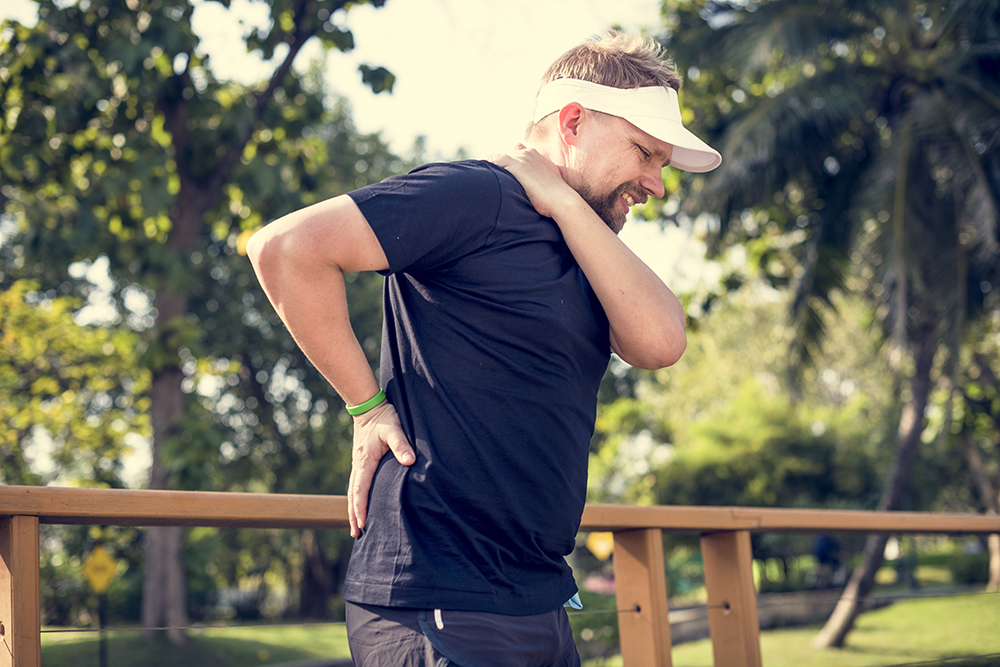You’re going about your day-to-day activities when you have a sudden onset of back pain. If accompanied by limited range of motion and stiffness, you might be suffering from a muscle strain in your back.
Back pain is one of the most common reasons for seeking medical care and affects nearly 60-80% of people throughout their lifetime. Back pain can be caused by a variety of conditions, including muscle strain.
A muscle strain is the partial or complete tear of the muscle fibers. This type of injury typically occurs from repeated overuse or misuse of a muscle. As such, athletes and individuals with physically-intensive jobs are at a higher risk of muscle strain. However, muscle strains can also occur from commonplace accidents such as slipping and falling.
If you think that a muscle strain might be the cause of your pain and discomfort, continue reading to learn more about the causes and symptoms of a back muscle strain, as well as how physical therapy can help.
What can cause a muscle strain in your back?
An acute or mild muscle strain occurs when there is only a small tear in the muscle fibers. A mild muscle strain can occur during everyday activities such as:
- Slipping or losing your footing.
- Jumping.
- Running.
- Lifting a heavy object.
- Twisting your body while lifting an object.
- Lifting an object while in an awkward position.
You are more likely to tear your muscle fibers during these activities if you have poor flexibility or do not warm up properly before engaging in physical activity. Muscle strains are also more likely to occur during cold weather. This is because your muscles are stiffer at lower temperatures. If you exercise during the winter or work in cold conditions, be sure to take the extra time to warm up beforehand.
Chronic muscle strains occur from repetitive movement that overexerts the muscle, causing it to tear. Most people associate this kind of injury with sports. In fact, muscle strains are the most common back injury in athletes, followed by spinal disc injuries. However, other kinds of repetitive movement can cause chronic muscle strain in your back, such as:
- Poor posture.
- Working a job that involves repeated pushing, pulling, or lifting motions, such as a warehouse stocker.
- Holding your back in an awkward position for long periods of time, such as when sitting at a desk or while sleeping.
- Sports like rowing, tennis, golf, or baseball
What are the symptoms of a muscle strain in your back?
You will likely be able to feel the muscle strain in your back as it occurs. Depending on the severity of the injury, you might experience:
- Sudden onset of pain.
- Bruising or discoloration.
- Redness or swelling.
- Soreness or tenderness.
- Limited range of movement.
- Stiffness.
- Muscle weakness.
- Muscle spasms.
3 PT techniques that can help reduce your back muscle strain symptoms
There are several at-home treatment options for a muscle strain in your back, including rest, hot and cold treatment, and anti-inflammatory medications. However, if your symptoms persist after two weeks, you should seek help from a health care specialist, such as a physical therapist.
There are several techniques that a physical therapist may use as part of your treatment plan to address your back muscle strain symptoms. Some of these techniques include:
- Therapeutic exercise — As part of your treatment plan, a physical therapist may design an exercise routine to help you regain your strength, flexibility, and range of motion after straining a back muscle. This technique is known as therapeutic exercise. Therapeutic exercise can involve activities like passive or assisted stretches and core strengthening exercises. The goal of this technique is to not only help you recover from a muscle strain in your back, but also help prevent future injury.
- Graston Technique® — The Graston Technique is a physical therapy technique that involves using specialized tools to massage and gently scrape the skin. During treatment, a physical therapist will use a set of stainless steel tools to identify and move the injured muscle tissue. This movement helps to break up scar tissue in the affected area. This physical therapy technique can help reduce pain and inflammation caused by a muscle strain in your back, as well as increase mobility.
- Electrical stimulation — A physical therapist may use electrical stimulation in order to reduce pain and muscle spasms caused by a muscle strain in your back. There are a variety of methods for administering electrical stimulation. In most cases, adhesive electrode pads will be placed in the target area. These electrode pads will send different types of currents through your nerves in order to help improve your symptoms. At first, this PT technique may sound intimidating. But, when used correctly under the guidance of a licensed physical therapist, electrical stimulation can help reduce your back muscle strain symptoms.
Our Panther physical therapists can support your recovery from back muscle strain
A muscle strain in your back can really throw a wrench in your daily routine. Luckily, you don’t have to suffer through your pain and discomfort alone. Our team of licensed physical therapists is prepared to help you recover from your back muscle strain and get back to living your life. You can request a free screening today to meet with one of our specialists. They can assess your current symptoms and design a custom treatment plan to meet your needs. Together, we can guide and support you through your healing process.
Contact our team today for more information on how we can help reduce your back muscle strain symptoms.

